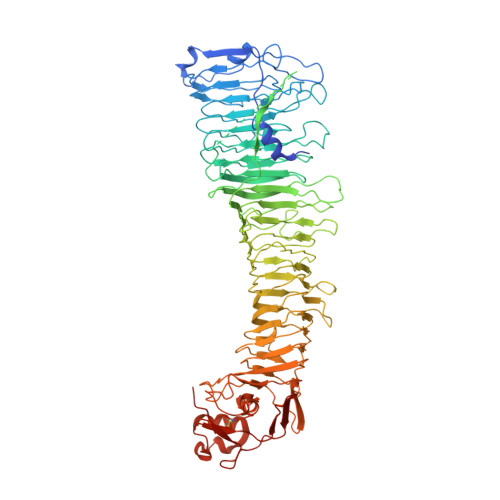Cryo-EM structures ofHelicobacter pylorivacuolating cytotoxin A oligomeric assemblies at near-atomic resolution.
Zhang, K., Zhang, H., Li, S., Pintilie, G.D., Mou, T.C., Gao, Y., Zhang, Q., van den Bedem, H., Schmid, M.F., Au, S.W.N., Chiu, W.(2019) Proc Natl Acad Sci U S A 116: 6800-6805
- PubMed: 30894496
- DOI: https://doi.org/10.1073/pnas.1821959116
- Primary Citation of Related Structures:
6NYF, 6NYG, 6NYJ, 6NYL, 6NYM, 6NYN - PubMed Abstract:
Human gastric pathogen Helicobacter pylori ( H. pylori ) is the primary risk factor for gastric cancer and is one of the most prevalent carcinogenic infectious agents. Vacuolating cytotoxin A (VacA) is a key virulence factor secreted by H. pylori and induces multiple cellular responses. Although structural and functional studies of VacA have been extensively performed, the high-resolution structure of a full-length VacA protomer and the molecular basis of its oligomerization are still unknown. Here, we use cryoelectron microscopy to resolve 10 structures of VacA assemblies, including monolayer (hexamer and heptamer) and bilayer (dodecamer, tridecamer, and tetradecamer) oligomers. The models of the 88-kDa full-length VacA protomer derived from the near-atomic resolution maps are highly conserved among different oligomers and show a continuous right-handed β-helix made up of two domains with extensive domain-domain interactions. The specific interactions between adjacent protomers in the same layer stabilizing the oligomers are well resolved. For double-layer oligomers, we found short- and/or long-range hydrophobic interactions between protomers across the two layers. Our structures and other previous observations lead to a mechanistic model wherein VacA hexamer would correspond to the prepore-forming state, and the N-terminal region of VacA responsible for the membrane insertion would undergo a large conformational change to bring the hydrophobic transmembrane region to the center of the oligomer for the membrane channel formation.
- Department of Bioengineering, James H. Clark Center, Stanford University, Stanford, CA 94305.
Organizational Affiliation:
















